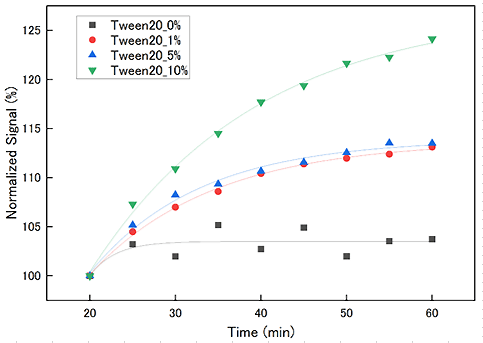ED-4-3
Effect of surfactant on dispersion of magnetic nanoparticles driven by femtosecond laser pulses evaluated by an HTS-SQUID system
17:45-18:00 28/11/2023
*Taiki Yamamoto, Sakuya Kako, Shu Asayama, Kei Yamashita, Jin Wang, Toshihiko Kiwa
Graduate School of Interdisciplinary Science and Engineering in Health Systems, Okayama University, 1-1-1 Tsushima-naka, Kita-ku, Okayama 700-8530 Japan
A magnetic immunoassay (MIA) has attracted the attention of many researchers since it is expected to realize a rapid and high-sensitive medical diagnosis. The MIA utilizes magnetic nanoparticles (MNPs), which generally show superparamagnetic properties, functionalized with antibodies to react with specific antigens. When the MNPs are conjugated with antigens in solutions, the AC magnetic susceptibility of MNPs decreases due to an increment in the particle volume. Thus, the concentration of the antigens could be measured by measuring the magnetic signals from the MNPs. Recently, a magnetic immunoassay system using high-Tc SQUIDs has been developed [1]. This system measures the third harmonic of the magnetic signals from the MNPs by applying the AC magnetic field with a frequency of 1.06 kHz and an amplitude of 8.5 mTp-p. A first-order differential coil was mounted coaxially with an excitation coil to detect the signals. The detected signals were transferred to the planar superconductive coils magnetically coupled with an HTS-SQUID chip after being amplified by a lock-in circuit. We used ramp-edge junctions made from SmBa2Cu3Oy (SmBCO) and La0.1-Er1.95Cu3Oy (La-ErBCO) for the HTS-SQUID. The sample solution in a quartz tube was located along the center axis of the coils.
However, the AC magnetic susceptivity of MNPs also decreases by aggregation of the MNPs, and it is difficult to distinguish the reduction of the signals by the conjugation from the signals by the aggregation. Therefore, quantitative measurement of the MIAs was challenging.
In our group, nonthermally dispersion of MNPs, driven by irradiating aggregated MNPs with femtosecond laser pulses [1], has been proposed. And we also realized the measurement of the magnetic signals during the laser pulse irradiation by installing a multimode optical fiber cable along the central axis of the coils to introduce femtosecond laser pulses to the MIA system.[2] The multimode fiber with a core diameter of 105 μm was used, which was connected to the femtosecond laser, which produced the laser pulses with a pulse width of 150 fs at FWHM, a center wavelength of 780 nm, and the repetition rate was 70 MHz, respectively.
But another problem with the dispersion by the laser was found. When MNPs are aggregated so strongly that they precipitate in the case of ions-distributed samples such as a serum solution, the dispersion by laser irradiation doesn’t occur.
In this study, the solution to the above problem, we found that the dispersion effect by the laser irradiation is exhibited by mixing the surfactant (Tween 20) with the solvent to prevent strong aggregation of MNPs.
Figure 1 shows the time evolution of the magnetic signal intensity of MNPs during femtosecond laser irradiation in each surfactant concentration. The diameter of MNPs was 180 nm on average. The concentration of sample particles was 2 mg/ml in 50 μl. We measured four samples 0%, 1%, 5%, and 10% of Tween20 with the MNPs. And each sample was adjusted to 1% of serum. The MNPs were first sonicated, and after leaving the adjusted sample for 20 min., we started laser irradiation at 21 min. The signal intensities plotted in Fig.1 were normalized at the time of 20 min.
It is apparent that the dispersion effect by laser irradiation is shown by using the Tween20 in Fig.1 result. The change of the signal at 60 min to 20 min was respectively 3.5%, 12.9%, 13.3%, and 23.7% for 0%, 1%, 5%, and 10% of Tween20. We search for the optimum concentration of Tween20 with a high signal-to-noise ratio and make the dispersion effective by laser irradiation.
[1] Kohei Kishimoto, Hiroto Kuroda, Misaki Tsubota, Kei Yamashita, Jin Wang, Kenji Sakai, Mohd Mawardi Saari, and Toshihiko Kiwa, “Dispersion of Fe3O4 Nanoparticle Beads Driven by Femtosecond Laser Pulses for Quantitative Magnetic Immunoassay Measurements,” ACS Applied Nano Materials, vol.5, No.11, pp.17258-17263, Nov. 2022
[2] T. Yamamoto, Kouhei Kishimoto, Hiroto Kuroda, Rekka Moriya, Kei Yamashita, Jin Wang, Kenji Sakai, Toshihiko Kiwa Presented at the 35th International Symposium on Superconductivity (ISS 2022), 30 Nov– 29 Dec-1, On-line, ED2-4
I would like to thank K. Sakai for technical assistance with the experiments.
